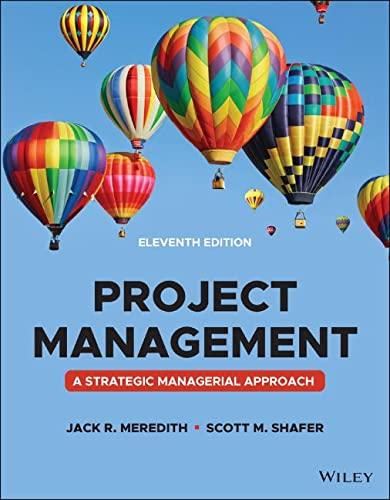Question
Directions: Imagine you work in the IT department of a financial services company that sells investments to, and manages investment portfolios for, high net worth
Directions:
Imagine you work in the IT department of a financial services company that sells investments to, and manages investment portfolios for, high net worth individuals. Your organization uses custom-built legacy software applications and systems to support its sales processes. The sales software applications and systems are not integrated, and they do not support an enterprise view of the sales processes throughout the organization. Management is frustrated because the sales applications and systems do not provide the information and reports necessary for them to measure, monitor, and manage sales production in the organization. Sales executives and account managers are frustrated because the sales software applications and systems do not support the sales cycle for the products and services that the organization sells.
You have been assigned to analyze your organization's sales processes and identify an IT system capable of improving the sales processes of your organization. In addition, your organization is looking for an easy-to-use, cloud-based Customer Relationship Management (CRM) solution to generate more leads, increase sales, improve customer service, reduce the cost of sales for the organization, and increase revenue.
Project implementation is arguably the most exciting stage of the project management process. It is during project implementation that project plans come to life and assumptions can be tested and measured in real-life scenarios.
Project documentation is also an important part of implementation. Documentation records and guides the process, specific steps taken, and inputs and outputs, and it provides additional reference and planning details needed to determine how to carry out each subset of a project.
Develop the following documentation for a project. All information in the documentation should align with these details in a Project Plan:
System diagram - a visual representationa graphic or chartof the components of your project
These include Microsoft 365, Google Cloud, Microsoft Azure,
SaaS, Hybrid Cloud, Salesforce, IaaS, Private Cloud, Amazon AWS
Network diagram - a visual representation of how data flows in your network: (Local Area Network (LAN), Metropolitan Area Network (MAN), Wide Area Network (WAN); Virtual Private Network (VPN) using Cisco Systems, Palo Alto Networks, Aruba Networks, Jupiter Networks)
Database design document - represents all data such as (Oracle Database, Microsoft SQR Server, Relational Databases) that is stored and maintained in the context of your project and includes these specific items:
- An entity-relationship diagram
- A data dictionary
- Table definitions.
Cybersecurity plan - a clearly articulated plan that explains how the project data and processes will be secured
Simple source code - (may be partial source code) code in HTML/JavaScript, Java, C++, or another programming language for at least one software application
Quality assurance and software test plan (Review the Sample Software Test Plan for an example of what information is typically included and how it is typically organized in a software test plan.
Sample Software Test Plan:
Project name: FinServ
Purpose of project:
Features To Be Tested/Not To Be Tested
Identify all features and combinations of features that will be tested. Also, describe features that will not be tested and explain why.
Testing Pass/Fail Criteria
Define the pass/fail criteria for each of the tests defined in this test plan.
Testing Approach
Describe the testing processes, testing types, and testing methods that will be used in this testing project. Discuss the testing strategy and how it will be applied to test this application.
Testing Cases
Define 12 to 15 test cases for your project.
Testing Materials (Hardware/Software Requirements)
Identify the resources needed for testing in this project. Include the physical facilities, hardware, software, tools, and any other resources that will be used during testing.
Testing Schedule
| Testing Activity | Duration | Resource | Comments |
|---|---|---|---|
| Test Plan Creation | 5 days | Test Manager | |
| Test Specification Creation | 10 days | Test Leads | |
| Test Specification Team Review | 5 days | Project Team | |
| Component Testing | 20 days | Component Testers | |
| Integration Testing | 20 days | Component and System Testers | |
| System Testing | 15 days | System Testers | |
| Performance Testing | 5 days | System Testers | |
| Use Case Validation | 10 days | System Testers | |
| Alpha Testing | 5 days | Product Managers/Analysts | |
| Beta Testing/Pilot Program | 20 days | Pilot Program End-Users |
Risks and Contingencies Matrix
| Risk | Probability | Risk Type | Owner | Contingencies/Mitigation Approach |
|---|---|---|---|---|
| Do not have enough skilled workers to test components as they are ready for testing. | 25% | Project Resources | Testing Manager | Testing schedule will be adjusted based on available resources. |
| Testing team member turnover | 10% | Project Resources | Testing Manager | Adjust testing schedules. Make sure testing team members are cross-trained on testing techniques in case a team member leaves the organization. |
Step by Step Solution
There are 3 Steps involved in it
Step: 1

Get Instant Access to Expert-Tailored Solutions
See step-by-step solutions with expert insights and AI powered tools for academic success
Step: 2

Step: 3

Ace Your Homework with AI
Get the answers you need in no time with our AI-driven, step-by-step assistance
Get Started


